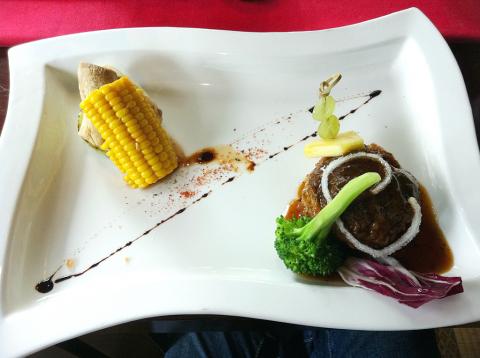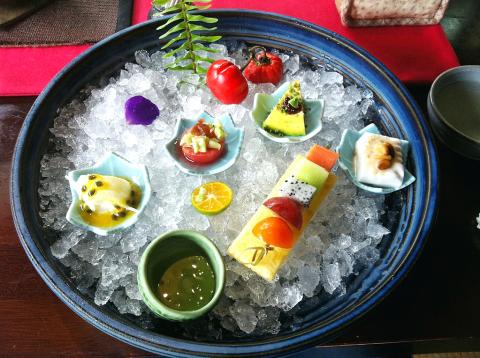Yangming Spring Green Kitchen (陽明春天) is one of a growing number of restaurants in Taipei where a meal is meant to be a tranquil affair as well as a culinary adventure.
Located in Yangmingshan, Yangming Spring closely follows the formula of another popular mountainside retreat, Shi-Yang Culture Restaurant (食養山房, reviewed in the Oct. 30, 2009, edition of the Taipei Times).
Like Shi-Yang, Yangming Spring draws inspiration from kaiseki (懷石), the Japanese approach to multi-course meals that emphasizes fine ingredients, an aesthetically pleasing presentation and formal service.

Photo: David Chen, Taipei Times
If you’re looking for both a peaceful escape from the city and a nourishing meal, Yangming Spring and its 5,000m2 grounds are the perfect place. Diners sit on tatami mats as the meals are presented at low, spacious wooden tables. During the day, you can gaze at the outdoor gardens through glass doors that surround the dining room. After the meal, stroll through the gardens, which are full of stone Buddhist statues collected from China.
There is no menu at Yangming Spring, which serves eight-course vegetarian meals that rely mainly on fresh, local ingredients. The only choice diners make is whether to spend NT$1,000 per person for the basic set or NT$2,000 per person, for which the kitchen uses more expensive ingredients such as imported truffles or rare mushrooms.
But there was plenty of refinement in the NT$1,000 per person meal I had with my family. Our visit started on a ritualistic note: We were each given a ceramic bowl filled with water, a slice of lemon and a few rose petals so we could wash our hands. Then came a delicate, faintly sweet herbal tea made from ashitaba (明日葉, literally “tomorrow’s leaf”).

Photo: David Chen, Taipei Times
According to Yangming Spring manager Kenneth Cheng (鄭啟南), ashitaba tea is served for both its flavor and overall medicinal properties. He says the restaurant grows the plant on Yangmingshan to make the own tea, which is brewed for four hours every day from freshly picked leaves.
Our meal began in earnest with bite-sized appetizers served on a bed of ice in a vibrant blue ceramic bowl. Everything was fresh and displayed novel combinations of flavor, but I particularly liked the cherry tomato topped with chopped bits of bitter melon and preserved plum, a wonderfully sweet and bitter combination. I was also impressed with the chunk of avocado topped with wasabe and imitation fish roe made of soy sauce, the texture of which was spot on.
Other courses included freshwater bamboo with mantou bread, a drinking vinegar to cleanse the palette, and a dessert of green tea pudding with fresh oranges and honeydew.
The highlight of the meal was the main course: lion’s mane mushroom (猴頭菇, literally “monkey’s head mushroom”), which has a meat-like texture. With the brown sauce ladled on top, the mushroom even looked like an oversized beef patty. Yangming Spring’s concoction had a beguiling taste and texture — savory and rich, soft and tender. I had to stop every now and then between bites to remind myself that this was not meat.
According to Cheng, this dish takes two days to prepare, as the mushroom is first boiled for 24 hours to soften it and then stewed for another 24 hours with kombu (a type of seaweed) and soy sauce for flavor.
The restaurant has several branches in Taipei, but I was less impressed on my visit to their Zhongxiao branch, which offers both an a la carte and a set menu. It wasn’t the food so much as the service — various members of the waitstaff were either clumsy and overbearing or incompetent.
That said, we did sample a few memorable dishes. The homemade radish cake (私房蘿蔔糕, NT$80) is very good, and a must-try item is the huma hewu (胡麻核物), a deep-fried dumpling filled with pureed pumpkin and sesame tofu. It’s available as part of one of the set meals, which are NT$680 and NT$980, or a la carte for NT$160.
Yangming Spring is best experienced at the Yangmingshan locale, as a visit requires an entire afternoon or evening, which allows you to take your time and truly soak in the sights and flavors.

May 11 to May 18 The original Taichung Railway Station was long thought to have been completely razed. Opening on May 15, 1905, the one-story wooden structure soon outgrew its purpose and was replaced in 1917 by a grandiose, Western-style station. During construction on the third-generation station in 2017, workers discovered the service pit for the original station’s locomotive depot. A year later, a small wooden building on site was determined by historians to be the first stationmaster’s office, built around 1908. With these findings, the Taichung Railway Station Cultural Park now boasts that it has

Wooden houses wedged between concrete, crumbling brick facades with roofs gaping to the sky, and tiled art deco buildings down narrow alleyways: Taichung Central District’s (中區) aging architecture reveals both the allure and reality of the old downtown. From Indigenous settlement to capital under Qing Dynasty rule through to Japanese colonization, Taichung’s Central District holds a long and layered history. The bygone beauty of its streets once earned it the nickname “Little Kyoto.” Since the late eighties, however, the shifting of economic and government centers westward signaled a gradual decline in the area’s evolving fortunes. With the regeneration of the once

In February of this year the Taipei Times reported on the visit of Lienchiang County Commissioner Wang Chung-ming (王忠銘) of the Chinese Nationalist Party (KMT) and a delegation to a lantern festival in Fuzhou’s Mawei District in Fujian Province. “Today, Mawei and Matsu jointly marked the lantern festival,” Wang was quoted as saying, adding that both sides “being of one people,” is a cause for joy. Wang was passing around a common claim of officials of the People’s Republic of China (PRC) and the PRC’s allies and supporters in Taiwan — KMT and the Taiwan People’s Party — and elsewhere: Taiwan and

Even by the standards of Ukraine’s International Legion, which comprises volunteers from over 55 countries, Han has an unusual backstory. Born in Taichung, he grew up in Costa Rica — then one of Taiwan’s diplomatic allies — where a relative worked for the embassy. After attending an American international high school in San Jose, Costa Rica’s capital, Han — who prefers to use only his given name for OPSEC (operations security) reasons — moved to the US in his teens. He attended Penn State University before returning to Taiwan to work in the semiconductor industry in Kaohsiung, where he